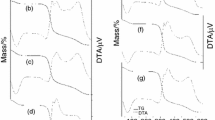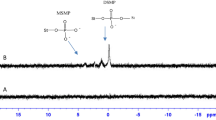Abstract
The physical, chemical, or enzymatic modified starches are well suited for industrial applications. Acid hydrolysis changes the physicochemical properties without impairing the granular structure of starch. The acid hydrolysis in alcoholic solution can recover the granule starches after modification. Starch, the most abundant carbohydrate in grains, roots and tubers, is composed by amylose and amylopectin. Corn starch represents 85% of the global starch market. The aim of this study was to evaluate the effects of soft acid, acid–ethanol and acid methanol solutions, considering its application in the paper industry. One sample remained as native. The other six samples were modified with acid, acid–ethanol and acid–methanol solutions, at concentrations of 0.1 and 0.5 mol L−1 (hydrochloric acid). The acid treatment changed the thermal (TG) and rheological (RVA) properties of the corn starch. The TG/DTG results showed shifted (up to 8 °C) stability temperature ranges for the samples treated with a higher concentration of HCl in ethanol and methanol solutions. The RVA results for final viscosity of the treated samples showed an intense reduction of 1405 cP related to the native sample. DSC curves demonstrated that the treatments slightly modified the gelatinization behavior of the starch. The micrographs showed small changes in granules average diameter size after the modification process. Acid hydrolysis did not change the crystalline pattern of corn starch, and its relative crystallinity was slightly affected. According to the results obtained for the acid/alcohol, modified starches present suitable properties for their application in the paper industry.





Similar content being viewed by others
References
Malumba P, Odjo S, Boudry C, Danthine S, Bindelle J, Beckers Y, Béra F. Physicochemical characterization and in vitro assessment of the nutritive value of starch yield from corn dried at different temperatures. Starch/Stärke. 2014;. doi:10.1002/star.201400012.
Hornung PS, Granza AG, De Oliveira CS, Lazzarotto M, Schnitzler E. Study of the effects of ultraviolet light and sodium hypochlorite solutions on properties of cassava starch granules. Food Biophys. 2015;. doi:10.1007/s11483-015-9402-7.
Beninca C, Demiate IM, Lacerda LG, Carvalho Filho MAS, Ionashiro M, Schnitzler E. Thermal behavior of corn starch granules modified by acid treatment at 30 and 50 °C. Eclét Quím. 2008;. doi:10.1590/S0100-46702008000300002.
Costa FJOG, Leivas CL, Waszczynskyj N, Godoi RCB, Helm CV, Colman TAD, Schnitzler E. Characterisation of native starches of seeds of Araucaria angustifolia from four germplasm collections. Thermochim Acta. 2013;. doi:10.1016/j.tca.2013.04.030.
Wang YJ, Truong VD, Wang L. Structures and rheological properties of corn starch as affected by acid hydrolysis. Carbohyd Polym. 2003;. doi:10.1016/S0144-8617(02)00323-5.
Lin JH, Singh H, Wen CY, Chang YH. Partial-degradation and heat-moisture dual modification on the enzymatic resistance and boiling-stable resistant starch content of corn starches. J Cereal Sci. 2011;. doi:10.1016/j.jcs.2011.05.001.
Mauer HW. Starch in the paper industry. In: James B, Roy W, editors. Starch. 3rd ed. San Diego: Academic Press; 2009. p. 657–713.
Gullichsen J, Paulapuro H. Papermaking science and technology. Book 4. Papermaking Chemistry. Jyväskylä: Fapet Oy; 1999, 389p.
Chung YL, Lai HM. Properties of cast films made of HCl–methanol modified corn starch. Starch/Stärke. 2007;. doi:10.1002/star.200700639.
Aggarwal P, Dollimore D. A thermal analysis investigation of partially hydrolyzed starch. Thermochim Acta. 1998;. doi:10.1016/S0040-6031(98)00355-4.
Sandhu KS, Singh N, Lim ST. A comparison of native and thinned acid normal and waxy corn starches: physicochemical, thermal morphological and pasting properties. LWT—Food Sci Technol. 2007;. doi:10.1016/j.lwt.2006.12.012.
Thys RCS Jr, Westfahl H, Noreña CPZ, Marczak LDF, Silveira NP, Cardoso MB. Effect of the alkaline treatment on the ultrastructure of C-type starch granules. Biomacromol. 2008;. doi:10.1021/bm800143w.
Higley JS, Love SL, Price WJ, Nelson JE, Huber KC. The rapid visco analyzer (RVA) as a tool for differentiating potato cultivars on the basis of flour pasting properties. Am J Potato Res. 2003;. doi:10.1007/BF02855691.
Beninca C, Colman TAD, Lacerda LG, Filho MASC, Bannach G, Schnitzler E. The thermal, rheological and structural properties of cassava starch granules modified with hydrochloric acid at different temperatures. Thermochim Acta. 2013;. doi:10.1016/j.tca.2012.10.020.
Luo ZG, Fu X, Gao QY, Yu SJ. Effect of acid hydrolysis in the presence of anhydrous alcohols on the structure, thermal and pasting properties of normal, waxy and high-amylose maize starches. Int J Food Sci Technol. 2011;. doi:10.1111/j.1365-2621.2010.02509.x.
Chung YL, Lai HM. Molecular and granular characteristics of corn starch modified by HCl–methanol at different temperatures. Carbohyd Polym. 2006;. doi:10.1016/j.carbpol.2005.10.031.
Mukerjea R, Slocum G, Robyt JF. Determination of the maximum water solubility of eight native starches and the solubility of their acidic–methanol and –ethanol modified analogues. Carbohyd Res. 2007;. doi:10.1016/j.carres.2006.10.022.
Hornung PS, de Oliveira CS, Lazzarotto M, Lazzarotto SRS, Schnitzler E. Investigation of the photo-oxidation of cassava starch granules. J Therm Anal Calorim. 2016;. doi:10.1007/s10973-015-4706-x.
Malucelli LC, Lacerda LG, Carvalho Filho MAS, Fernández DER, Demiate IM, Oliveira CS, Schnitzler E. Porous waxy maize starch: thermal, structural and viscographic properties of modified granules obtained by enzyme treatment. J Therm Anal Calorim. 2015;. doi:10.1007/s10973-015-4483-6.
Colman TAD, Demiate IM, Schnitzler E. The effect of microwave radiation on some thermal, rheological and structural properties of cassava starch. J Therm Anal Calorim. 2014;. doi:10.1007/s10973-012-2866-5.
Oliveira CS, Andrade MMP, Colman TAD, Costa FJOG, Schnitzler E. Thermal, structural and rheological behaviour of native and modified waxy corn starch with hydrochloric acid at different temperatures. J Therm Anal Calorim. 2014;. doi:10.1007/s10973-013-3307-9.
Leivas CL, Costa FJOG, Almeida RR, Freitas RJS, Stertz SC, Schnitzler E. Structural characteristics physico-chemical, thermal and pasting properties of potato (Solanum tuberosum L.) flour: study of different cultivars and granulometries. J Therm Anal Calorim. 2013;. doi:10.1007/s10973-012-2395-2.
Lacerda LG, Colman TAD, Bauab T, Carvalho-Filho MAS, Demiate IM, Vasconcelos EC, Schnitzler E. Thermal, structural and rheological properties of starch from avocado seeds (Persea Americana, Miller) modified with standard sodium hypochlorite solutions. J Therm Anal Calorim. 2014;. doi:10.1007/s10973-013-3349-z.
Robyt JF, Choe JY, Hahn RS, Fuchs EB. Acid modification of starch granules in alcohols: effects of temperature, acid concentration, and starch concentration. Carbohyd Res. 1996;. doi:10.1016/0008-6215(95)00347-9.
Ramos AP, Demiate IM, Schnitzler E, Bedin AC, Telis-Romero J, Lopes-Filho JF. Morphological, thermal and physicochemical characteristics of small granules starch from Mirabilis jalapa L. Thermochim Acta. 2015;. doi:10.1016/j.tca.2015.01.001.
Shin SI, Lee CJ, Kim MJ, Choi SJ, Choi HJ, Kim MY, Moon TW. Structural characteristics of low-glycemic response rice starch produced by citric acid treatment. Carbohyd Polym. 2009;. doi:10.1016/j.carbpol.2009.05.017.
Sun Q, Zhu X, Si F, Xiong L. Effect of acid hydrolysis combined with heat moisture treatment on structure and physicochemical properties of corn starch. J Food Sci Technol. 2015;. doi:10.1007/s13197-013-0998-7.
Babu AS, Parimalavalli R, Jagannadham K, Rao JS. Chemical and structural properties of sweet potato starch treated with organic and inorganic acid. J Food Sci Technol. 2015;. doi:10.1007/s13197-014-1650-x.
Hoover R, Vasanthan T. Effect of heat moisture treatment on the structure and physicochemical properties of cereal, legume and tuber starches. Carbohyd Res. 1994;. doi:10.1016/0008-6215(94)90004-3.
Becerra V, Odermatt J. Direct determination of cationic starches in paper samples using analytical pyrolysis. J Anal Appl Pyrol. 2014;. doi:10.1016/j.jaap.2013.11.024.
Maurer HW. Starch and starch products in surface sizing and paper coating. Atlanta: TAPPI Press; 2001.
Chauhan VS, Bhardwaj NK. Efficacy of carbohydrate polymers in filler preflocculation for use in papermaking. Arab J Chem. 2015;. doi:10.1016/j.arabjc.2015.08.002.
Cavallini CM, Franco CML. Effect of acid–ethanol treatment followed by ball milling on structural and physicochemical characteristics of cassava starch. Starch/Stärke. 2010;. doi:10.1002/star.200900231.
Sodhi NS, Chang YH, Kaur N, Kohyama K. Effect of acid–methanol treatment on the molecular structure and physicochemical properties of lentil (Lens culinaris Medik) starch. Food Hydrocoll. 2009;. doi:10.1016/j.foodhyd.2009.05.004.
Lin JH, Lee SY, Chang YH. Effect of acid–alcohol treatment on the molecular structure and physicochemical properties of maize and potato starches. Starch/Stärke. 2003;. doi:10.1016/S0144-8617(03)00145-0.
Okunlola A, Akingbala O. Characterization and evaluation of acid-modified starch of Dioscorea oppositifolia (Chinese yam) as a binder in chloroquine phosphate tablets. Braz J Pharm Sci. 2013;. doi:10.1590/S1984-82502013000400009.
Nachtergaele W, Van Nuffel J. Starch as stilt material in carbonless copy paper—new developments. Starch/Stärke. 1989;. doi:10.1002/star.19890411006.
White MA. The chemistry behind carbonless copy paper. J Chem Educ. 1998;. doi:10.1021/ed075p1119.
Burrell MM. Starch: the need for improved quality or quantity—an overview. J Exp Bot. 2003;. doi:10.1093/jxb/erg049.
Ferrini LMK, Rocha TS, Demiate IM, Franco CML. Effect of acid–methanol treatment on the physicochemical and structural characteristics of cassava and maize starches. Starch/Stärke. 2008;. doi:10.1002/star.200700712.
Zhang L, Xie W, Zhao X, Liu Y, Gao W. Study on the morphology, crystalline structure and thermal properties of yellow ginger starch acetates with different degrees of substitution. Thermochim Acta. 2009;. doi:10.1016/j.tca.2009.05.019.
Almeida RR, Lacerda LG, Murakami FS, Bannachd G, Demiate IM, Soccol CR, Carvalho Filho MAS, Schnitzler E. Thermal analysis as a screening technique for the characterization of babassu flour and its solid fractions after acid and enzymatic hydrolysis. Thermochim Acta. 2011;. doi:10.1016/j.tca.2011.02.029.
Xie XS, Liu Q, Cui SW. Studies on the granular structure of resistant starches (type 4) from normal, high amylose and waxy corn starch citrates. Food Res Int. 2006;. doi:10.1016/j.foodres.2005.08.004.
Acknowledgements
The authors thanks CAPES, CNPq, Universidade Estadual de Ponta Grossa and Embrapa Florestas.
Author information
Authors and Affiliations
Corresponding author
Rights and permissions
About this article
Cite this article
de Andrade de Siqueira, G.L., Hornung, P.S., da Silveira, A.C. et al. Impact of treatment with HCL/alcoholic in the modification of corn starch. J Therm Anal Calorim 129, 1705–1713 (2017). https://doi.org/10.1007/s10973-017-6299-z
Received:
Accepted:
Published:
Issue Date:
DOI: https://doi.org/10.1007/s10973-017-6299-z




